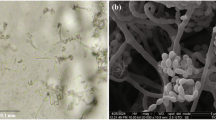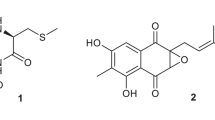Abstract
A novel Gram-stain-positive actinomycete, designated MB-PO13T, was isolated from a tunicate (Molgula manhattensis) collected in Tokyo Bay, Japan, and its taxonomic position was studied by a polyphasic approach. Phylogenetic analysis based on 16S rRNA gene sequence comparisons revealed that strain MB-PO13T was closely related to Streptomyces graminisoli JR-12T (99.72% 16S rRNA gene sequence similarity) and Streptomyces shenzhenensis 172115T (99.23%). The strain contained LL-diaminopimelic acid in the whole-cell hydrolysate. The predominant menaquinones were MK-9(H8) and MK-9(H6) and the major fatty acids were anteiso-C15:0, iso-C16:0, iso-C14:0 and C16:0. These data supported the affiliation of the novel strain to the genus Streptomyces. Meanwhile, results of DNA−DNA hybridization and physiological and biochemical tests indicated that strain MB-PO13T was distinguished from known Streptomyces type strains. Therefore, strain MB-PO13T represents a novel species of the genus Streptomyces for which the name Streptomyces hyaluromycini sp. nov. is proposed; the type strain is MB-PO13T (=NBRC 110483T =DSM 100105T).
Similar content being viewed by others
Log in or create a free account to read this content
Gain free access to this article, as well as selected content from this journal and more on nature.com
or
References
Waksman, S. A. & Henrici, A. T. The nomenclature and classification of the actinomycetes. J. Bacteriol. 46, 337–341 (1943).
Witt, D. & Stackebrandt, E. Unification of the genera Streptoverticillium and Streptomyces, and amendation of Streptomyces Waksman and Henrici 1943, 339AL. Syst. Appl. Microbiol. 13, 361–371 (1990).
Wellington, E. M. H., Stackebrandt, E., Sanders, D., Wolstrup, J. & Jorgensen, N. O. G. Taxonomic status of Kitasatosporia, and proposal unification with Streptomyces on the basis of phenotypic and 16S rRNA analysis and emendation of Streptomyces Waksman and Henrici 1943, 339AL. Int. J. Syst. Bacteriol. 42, 156–160 (1992).
Zhang, Z., Wang, Y. & Ruan, J. A proposal to revive the genus Kitastospora (Ōmura, Takahashi, Iwai, and Tanaka 1982). Int. J. Syst. Bacteriol. 47, 1048–1054 (1997).
Parte, A. C. . LPSN–List of prokaryotic names with standing in nomenclature. http://www.bacterio.net/index.html (2015).
Zotchev, S. B. Marine actinomycetes as an emerging resource for the drug development pipelines. J. Biotechnol. 158, 168–175 (2012).
Dharmaraj, S. Marine Streptomyces as a novel source of bioactive substances. World J. Microbiol. Biotechnol. 26, 2123–2139 (2010).
Fenical, W. & Jensen, P. R. Developing a new resource for drug discovery: marine actinomycete bacteria. Nat. Chem. Biol. 2, 666–673 (2006).
Petrey, A. C. & de la Motte, C. a. Hyaluronan, a crucial regulator of inflammation. Front. Immunol. 5, 1–13 (2014).
Sakamoto, K., Nagai, H. & Koda, A. Role of hyaluronidase in immediate hypersensitivity reaction. Immunopharmacology 2, 139–146 (1980).
Furuya, T. et al. Biochemical characterization of glycyrrhizin as an effective inhibitor for hyaluronidases from bovine testis. Biol. Pharm. Bull. 20, 973–977 (1997).
Harunari, E. et al. Hyaluromycin, a new hyaluronidase inhibitor of polyketide origin from marine Streptomyces sp. Mar. Drugs 12, 491–507 (2014).
Hucker, G. J. & Conn, H. J. Methods of gram staining. Tech. Bull. NYSAES 23, 1–37 (1923).
Shirling, E. B. & Gottlieb, D. Methods for characterization of Streptomyces species. Int. J. Syst. Evol. Microbiol. 16, 313–340 (1966).
Yu, Z. & Morrison, M. Improved extraction of PCR-quality community DNA from digesta and fecal samples. Biotechniques 36, 808–812 (2004).
Heuer, H., Krsek, M., Baker, P., Smalla, K. & Wellington, E. M. H. Analysis of actinomycete communities by specific amplification of genes encoding 16S rRNA and gel-electrophoretic separation in denaturing gradients. Appl. Environ. Microbiol. 63, 3233–3241 (1997).
Kim, O. S. et al. Introducing EzTaxon-e: A prokaryotic 16s rRNA gene sequence database with phylotypes that represent uncultured species. Int. J. Syst. Evol. Microbiol. 62, 716–721 (2012).
Thompson, J. D., Higgins, D. G. & Gibson, T. J. CLUSTAL W: improving the sensitivity of progressive multiple sequence alignment through sequence weighting, position-specific gap penalties and weight matrix choice. Nucleic Acids Res. 22, 4673–4680 (1994).
Saitou, N. & Nei, M. The neighbour-joining method: a new method for reconstructing phylogenetic trees. Mol. Biol. Evol. 4, 406–425 (1987).
Felsenstein, J. Evolutionary trees from DNA sequences: a maximum likelihood approach. J. Mol. Evol. 17, 368–376 (1981).
Fitch, W. M. Toward defining the course of evolution: minimum change for a specific tree topology. Syst. Biol. 20, 406–416 (1971).
Tamura, K., Stecher, G., Peterson, D., Filipski, A. & Kumar, S. MEGA6: molecular evolutionary genetics analysis version 6.0. Mol. Biol. Evol. 30, 2725–2729 (2013).
Felsenstein, J. Confidence limits on phylogenies: an approach using the bootstrap. Evolution 39, 783–791 (1985).
Saito, H. & Miura, K. I. Preparation of transforming deoxyribonucleic acid by phenol treatment. Biochim. Biophys. Acta 72, 619–629 (1963).
Hamada, M. et al. Luteimicrobium album sp. nov., a novel actinobacterium isolated from a lichen collected in Japan, and emended description of the genus Luteimicrobium. J. Antibiot. 65, 427–431 (2012).
Ezaki, T., Hashimoto, Y. & Yabuuchi, E. Fluorometric deoxyribonucleic acid-deoxyribonucleic acid hybridization in microdilution wells as an alternative to membrane filter hybridization in which radioisotopes are used to determine genetic relatedness among bacterial strains. Int. J. Syst. Bacteriol. 39, 224–229 (1989).
Hasegawa, T., Takizawa, M. & Tanida, S. A rapid analysis for chemical grouping of aerobic actinomycetes. J. Gen. Appl. Microbiol 29, 319–322 (1983).
Hamada, M., Iino, T., Iwami, T. & Harayama, S. Mobilicoccus pelagius gen. nov., sp. nov. and Piscicoccus intestinalis gen. nov., sp. nov., two new members of the family Dermatophilaceae, and reclassification of Dermatophilus chelonae (Masters et al. 1995) as Austwickia chelonae gen. nov., comb. nov. J. Gen. Appl. Microbiol. 436, 427–436 (2010).
Sasser, M. Identification of Bacteria by Gas Chromatography of Cellular Fatty Acids, MIDI Technical Note 101, MIDI Inc., Newark, DE, USA, (1990).
Wayne, L. G. et al. Report of the ad hoc committee on reconciliation of approaches to bacterial systematics. Int. J. Syst. Bacteriol. 37, 463–464 (1987).
Zhang, B.-H. et al. Streptomyces jiujiangensis sp. nov., isolated from soil in South China. Antonie Van Leeuwenhoek 105, 763–770 (2014).
Lee, H. J. & Whang, K. S. Streptomyces graminisoli sp. nov. and Streptomyces rhizophilus sp. nov., isolated from bamboo (Sasa borealis rhizosphere soil. Int. J. Syst. Evol. Microbiol. 64, 1546–1551 (2014).
Hu, H. et al. Streptomyces shenzhenensis sp. nov., a novel actinomycete isolated from mangrove sediment. Antonie Van Leeuwenhoek 100, 631–637 (2011).
Lee, H. J., Han, S. I. & Whang, K. S. Streptomyces gramineus sp. nov., an antibiotic-producing actinobacterium isolated from bamboo (Sasa borealis rhizosphere soil. Int. J. Syst. Evol. Microbiol. 62, 856–859 (2012).
Acknowledgements
The authors are grateful to Dr Ken-ichiro Suzuki (NBRC) and NBRC staff for their assistance for chemotaxonomic study. This work was supported by the Japan Society for the Promotion of Science (JSPS) for Young Scientists (15K18692) and Institute for Fermentation, Osaka (IFO) for Young Scientists.
Author information
Authors and Affiliations
Corresponding author
Ethics declarations
Competing interests
The authors declare no conflict of interest.
Additional information
Supplementary Information accompanies the paper on The Journal of Antibiotics website
Supplementary information
Rights and permissions
About this article
Cite this article
Harunari, E., Hamada, M., Shibata, C. et al. Streptomyces hyaluromycini sp. nov., isolated from a tunicate (Molgula manhattensis). J Antibiot 69, 159–163 (2016). https://doi.org/10.1038/ja.2015.110
Received:
Revised:
Accepted:
Published:
Issue date:
DOI: https://doi.org/10.1038/ja.2015.110
This article is cited by
-
Draft genome sequence of Streptomyces hyaluromycini MB-PO13T, a hyaluromycin producer
Standards in Genomic Sciences (2018)
-
Draft genome sequence of Streptomyces sp. TP-A0867, an alchivemycin producer
Standards in Genomic Sciences (2016)



